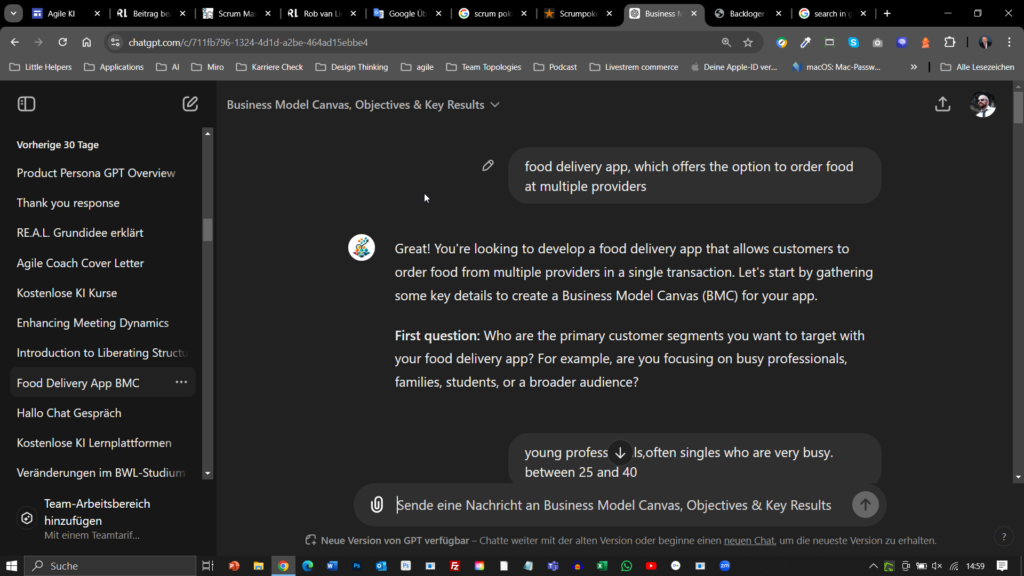I find it really awesome, that agility and AI are building an awesome symbiosis. Because tasks in agile can be challenging sometimes. By buddy ChatGPT is , in those moments, a great supporter and facilitator.
Scrum Estimator

Estimator GPT
One of the biggest challenges in Scrum are the so-called estimations. At the beginning of a so-called sprint (a period of 2 to 4 weeks that repeats until the end of the project) there is always an event (in Scrum the regular meetings are called events) in which the development team determines how many requirements can be implemented in the upcoming sprint. This is called sprint planning.
Here, the requirements that the colleagues from development consider feasible for the upcoming iteration are selected from the board with the noted requirements (the product backlog). This is done using story points. This term comes from the fact that the customer requirements are written in a specific template, which is called a user story. The customer/end user is always at the centre of Scrum.
There are heated discussions in the agile community about story points alone, which can sometimes feel like a war. Basically, it’s simple But simple would be too simple As a Dutchman, I always try to keep it as simple (K.I.S.S. Keep It Stupid Simple) and pragmatic as possible. The world is already complicated enough. For me, it’s always about the effort of a customer requirement for a feature (e.g. navigation)
These story points should serve as an indicator that the developers can use to estimate how many tasks they can take on and complete. As a Scrum Master, it is my job to support the team in estimating. Often, not everyone’s level of knowledge on a particular story is the same. One colleague assumes that the task can be completed quickly, while another colleague has the feeling that more effort is needed to finish the task.
Normally there is a game, usually online (hello gamification) called Scrum Poker (please find out how the company handles the GDPR). There, each colleague chooses the card with the number that suits them. In most cases, the Fibonacci number sequence is used.

Scrum Poker Board
What I like about this GPT is its reliability. You copy the user story in the field and AI calculates the story point for this task

Estimation based on user story
These stories are written by the product owner after the requirements meeting with the customer. With the help of the GPT, this story can be analyzed and the story points determined. Of course, always in exchange with the team. Because the strength of agile working is transparent communication at eye level. Ultimately, the colleagues in the development team are the experts.
Business Model Canvas, Objectives & Key Results
Create your Business Model Canvas (BMC) & the Objectives & Key Results (OKR) you need to start or grow your business. The process will take about 20-60 minutes — Click “Let’s Begin” & let ChatGPT guide you!

I entered an idea that I had when I started my thesis for the Digital Transformation certification.

After I inserted more data, I asked ChatGPT to “visualize” the answers more.

There is another GPT with which you can fill out sheets (Google Excel) with this data in a structured way.
There is also a template that visualizes the entire business model more and thus presents it more transparently (I am not a fan of Excel. Below is a picture of the canvas.

Source: https://www.strategyzer.com/
Liberating Structures

Liberating Structures ist ein gut gefüllter Methodenkoffer, der erlaubt, alle zu beteiligen. Die einzelnen Liberating Structures ermöglichen, Herausforderungen gezielt und schrittweise zu bewältigen. Sie kombinieren sorgfältig strukturiert geschickte Abfolgen, zielführende Fragestellungen und erhellende Metaphern. So können sie Interaktionen befreien.
. https://www.liberatingstructures.com/

Let’s see, how it looks in ChatGPT. I have chosen the option “I’m short on time but facing a big challenge“

More to come soon 😉
